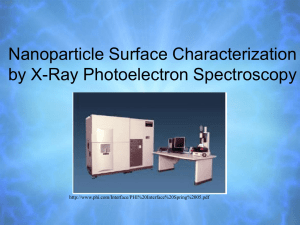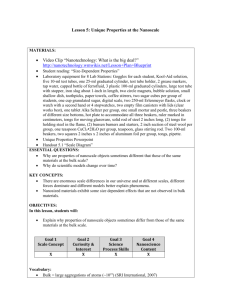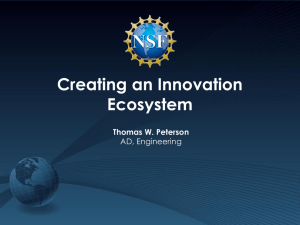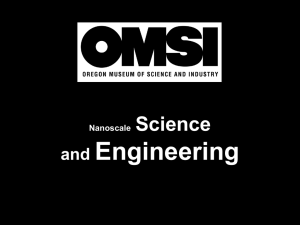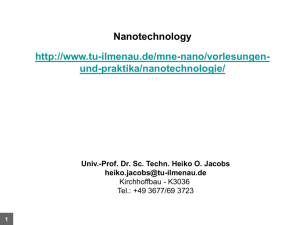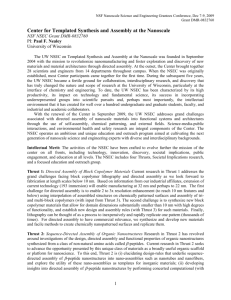Richard Siegel - NSF Nanoscale Science and Engineering Grantees
advertisement
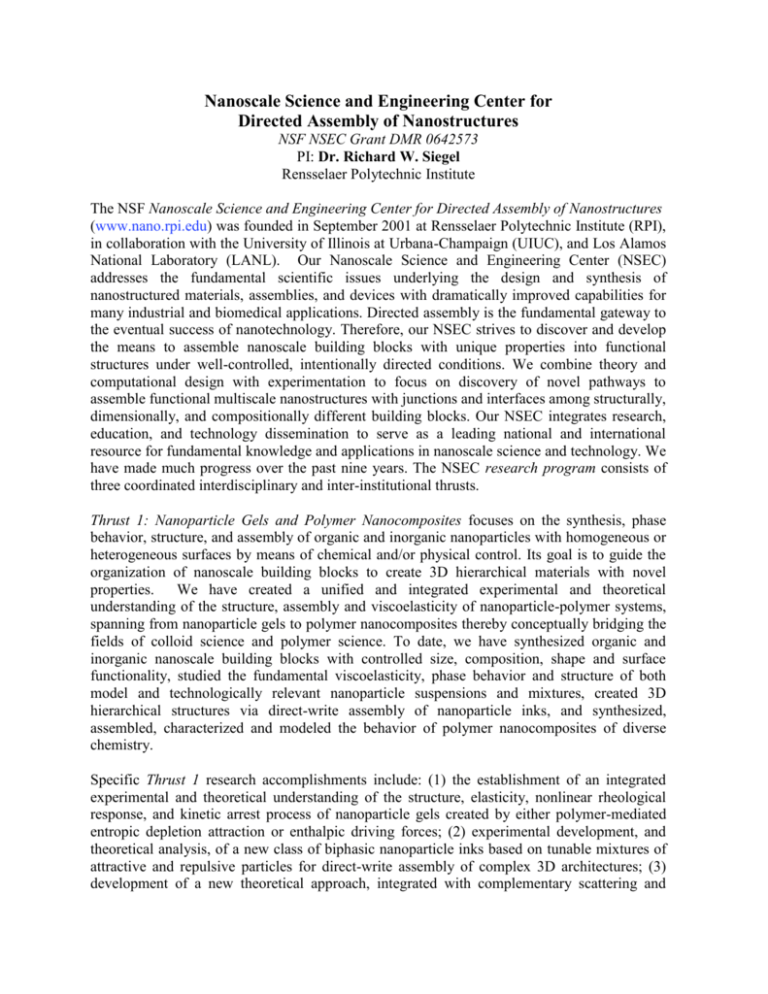
Nanoscale Science and Engineering Center for Directed Assembly of Nanostructures NSF NSEC Grant DMR 0642573 PI: Dr. Richard W. Siegel Rensselaer Polytechnic Institute The NSF Nanoscale Science and Engineering Center for Directed Assembly of Nanostructures (www.nano.rpi.edu) was founded in September 2001 at Rensselaer Polytechnic Institute (RPI), in collaboration with the University of Illinois at Urbana-Champaign (UIUC), and Los Alamos National Laboratory (LANL). Our Nanoscale Science and Engineering Center (NSEC) addresses the fundamental scientific issues underlying the design and synthesis of nanostructured materials, assemblies, and devices with dramatically improved capabilities for many industrial and biomedical applications. Directed assembly is the fundamental gateway to the eventual success of nanotechnology. Therefore, our NSEC strives to discover and develop the means to assemble nanoscale building blocks with unique properties into functional structures under well-controlled, intentionally directed conditions. We combine theory and computational design with experimentation to focus on discovery of novel pathways to assemble functional multiscale nanostructures with junctions and interfaces among structurally, dimensionally, and compositionally different building blocks. Our NSEC integrates research, education, and technology dissemination to serve as a leading national and international resource for fundamental knowledge and applications in nanoscale science and technology. We have made much progress over the past nine years. The NSEC research program consists of three coordinated interdisciplinary and inter-institutional thrusts. Thrust 1: Nanoparticle Gels and Polymer Nanocomposites focuses on the synthesis, phase behavior, structure, and assembly of organic and inorganic nanoparticles with homogeneous or heterogeneous surfaces by means of chemical and/or physical control. Its goal is to guide the organization of nanoscale building blocks to create 3D hierarchical materials with novel properties. We have created a unified and integrated experimental and theoretical understanding of the structure, assembly and viscoelasticity of nanoparticle-polymer systems, spanning from nanoparticle gels to polymer nanocomposites thereby conceptually bridging the fields of colloid science and polymer science. To date, we have synthesized organic and inorganic nanoscale building blocks with controlled size, composition, shape and surface functionality, studied the fundamental viscoelasticity, phase behavior and structure of both model and technologically relevant nanoparticle suspensions and mixtures, created 3D hierarchical structures via direct-write assembly of nanoparticle inks, and synthesized, assembled, characterized and modeled the behavior of polymer nanocomposites of diverse chemistry. Specific Thrust 1 research accomplishments include: (1) the establishment of an integrated experimental and theoretical understanding of the structure, elasticity, nonlinear rheological response, and kinetic arrest process of nanoparticle gels created by either polymer-mediated entropic depletion attraction or enthalpic driving forces; (2) experimental development, and theoretical analysis, of a new class of biphasic nanoparticle inks based on tunable mixtures of attractive and repulsive particles for direct-write assembly of complex 3D architectures; (3) development of a new theoretical approach, integrated with complementary scattering and mechanical experiments, to fundamentally understand and establish design rules for how competing enthalpy and entropy effects determine the multiscale structure, phase behavior, and viscoelasticity of polymer nanocomposites composed of bare fillers; and (4) synergistic employment of novel synthesis, physical characterization, statistical mechanical theory, and computer simulation to establish the role of competing attractive and repulsive forces on isotropic and anisotropic nanoparticle assembly, mechanical properties, and dynamics of a broad class of polymer nanocomposites based on tailored grafted-chain filler particles of controlled architecture. Thrust 2: Nanostructured Biomolecule Composite Architectures is focused on incorporation of biological macromolecules into nanocomposite materials to enable specific applications, including directed assembly based on biorecognition and biocatalysis, which impact tissue engineering, biosensing, self-cleaning and self-repair capabilities, and the design of novel functional nanostructures. Its goal is to enable the efficient and selective interaction of biomolecules with synthetic nanoscale building blocks to create useful assemblies. Specific Thrust 2 research accomplishments include: (1) the discovery of the effect of nanoscale molecular curvature on biomolecule stability and function; and (2) a mechanistic understanding of multiscale phase behavior leading to functional biomolecule composite nanostructure assemblies. With respect to the former, we have discovered the unique behavior of proteins on highly curved surfaces, on which the arc of curvature is on the same scale as that of proteins. This unexpected result has been studied mechanistically and the influence of surface curvature on protein structure, stability, and (in the case of enzymes) catalytic function has been elucidated for the first time, both experimentally and computationally. As a result, we have identified a controllable nanoscale surface property that can control protein function that adds to more well-understood surface chemical properties. Stabilized proteins have been used to increase the efficiency of enzyme-nanomaterial-polymer composites that are being used commercially as antifouling and antimicrobial surfaces that are safe and efficient. With respect to the latter, molecular to nanoscale, and ultimately micro- to macroscale phase behavior has been elucidated both experimentally and computationally toward the goal of designing functional biomaterial systems. Another very significant advance has been made in this thrust in elucidating the ‘rules’ of interaction and self-assembly using electrostatic effects in water, which have considerable implications and impact for problems in viable alternative energy areas (e.g., self-assembled systems for photovoltaics, photocatalysis, biofuels) and for problems in human health and disease (e.g., gene and drug delivery, cystic fibrosis, antimicrobials, viral fusion). An example of the impact on human health is in the design of cell-penetrating peptides that have the unique ability to disrupt cellular membranes with potential use as antimicrobial agents. Extensive molecular dynamics simulations of relevant peptides (e.g., HIV Tat) have been performed to understand the mechanism of physicochemical action of the peptides in their ability to disrupt the phospholipid bilayer structure, as well as controlling water structure leading to a gain in our understanding of pore formation in soft materials. Similar mechanisms may be involved in many other biological systems, like formation of pores by antimicrobial peptides, and voltage gating by movement of Arg-rich α-helices in ion channels. In addition, investigations of DNAzyme-catalyzed assembly and disassembly of nanoparticle-biomolecule conjugates have led to the creation of novel colorimetric environmental sensors with precise selectivity, high sensitivity, and very wide dynamic range. Thrust 3: Serving Society through Education and Outreach has as its goal to serve society by: (i) raising public science literacy through informal and formal education, and reaching a diverse audience to broaden the technical reach of our NSEC through programs that are carefully designed to integrate nanotechnology research with education, and (ii) enhancing the responsible, safe, and efficient transfer of nanotechnology developments to industry, the primary route through which society can benefit from the fruits of our research. Hence, our continuing vision encompasses research, education, and outreach through interactions with students of all ages and researchers in universities, national laboratories, and industry. Specific Thrust 3 accomplishments include (1) spawning the exciting Molecularium® Project, which has created and released to worldwide audiences the entertaining and educational (“stealth education”) science-literacy shows “Riding Snowflakes”, a 23-minute digital-dome show, and “Molecules to the MAX!”, a 42-minute giant-screen (e.g., Imax) show in both 2D and 3D formats; (2) development of high school curricula that have led to two ongoing courses in local high schools and nanotechnology modules in three others; (3) involvement by more than 40 undergraduates in summer research, a majority of whom are women or underrepresented minorities; (4) creation of a book Nanocomposite Science and Technology (WileyVCH, 2003); (5) spin off of three start-up companies – ANDalyze, Inc.(formerly DzymeTech, Inc.); Solidus Biosciences, Inc.; and The Paper Battery Company, Inc., all stemming from our NSEC research; and (6) transfer of several technologies based on NSEC research to our industry partners ABB Corporation, Albany International, and Chisso Corporation, including several licensed patents, that have been followed up by related commercialization activities. There have thus been a significant number of major accomplishments in our NSEC program during the nine-year period 2001-2010. Outstanding progress has been made in research, education, and outreach and we will continue to increase our NSF–NSEC’s positive impact on both science and society as we move forward in the coming years. For more information please contact us at nanocenter@rpi.edu.
